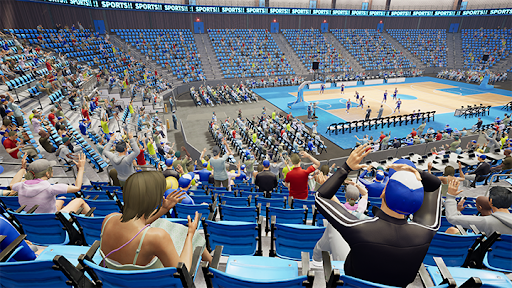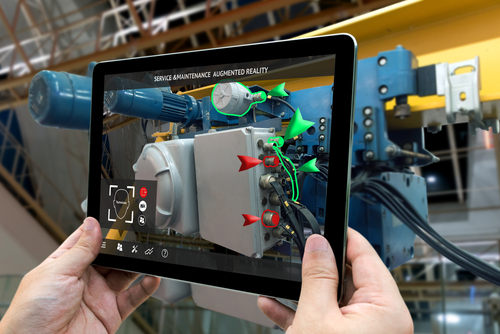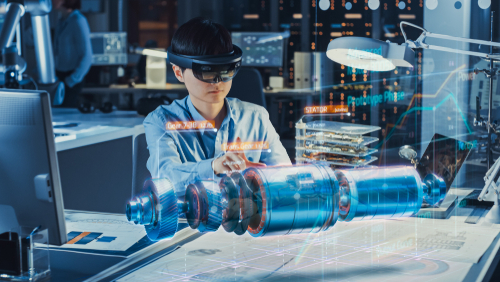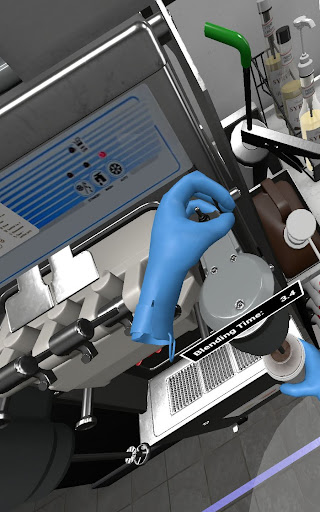A Board of Directors’ Guide to Using Virtual Reality
A Board of Directors’ Guide to Using Virtual Reality (VR) to Increase Shareholder Value and Profitability
Executive Summary & Table of Contents
Let go of any misconceptions you have about Virtual Reality (VR). Enterprises today are using VR in ways you might not have thought of to achieve increased shareholder value and profitability.
This white paper explores how Boards of Directors can help enterprises use Virtual Reality (VR) and its associated technologies – Augmented Reality (AR) and Mixed Reality (MR) – to achieve business goals all enterprises share:
VR, AR and MR fall under the heading of Extended Reality (XR). In addition to value and cost goals, XR technology can help your enterprise with common Board initiatives:
- Diversity, Equity and Inclusion (DEI)
- With immersive DEI training that includes inclusion and harassment modules where you realistically and effectively experience situations firsthand and receive personalized feedback on your interactions.
- Environmental, Social & Governance (ESG)
- With the ability to: eliminate travel by training remotely in a realistically simulated environment, eliminate waste during the training process, decrease waste after training by creating more confident workers, and train in social and soft skills.
- Digital transformation
- In areas such as employee training, product design, digital twins and virtual environment simulations, and the Metaverse.
VR, AR and MR are not as costly nor technical as you might think. Just like when laptops and cell phones were first introduced, there is a learning curve to incorporating XR devices into your workflow, and a capital expenditure for the hardware. Access to a platform and modules is often subscription-based.
Platforms exist that can integrate into the Learning Management System in your tech stack and are SOC 2 compliant to alleviate security risk. Turnkey solutions that make using the technology as easy as turning on the devices and signing in to use the software also exist.
Implementing XR has already proven to quickly result in ROI, and the costs continue to rapidly decline. The time to transform your enterprise with XR technology is now.
Introduction
If you’re a member of a corporate Board of Directors, you’re probably aware that Virtual Reality (VR) has progressed well beyond the science fantasy of the Matrix movies. In the past two decades, VR has become a useful tool for many enterprises, especially in specialized training (e.g. ship building, pigging, car mechanic training) and digital design (e.g. for architects, automotive vehicle designers, etc.).
But you might have formed some mistaken ideas about how VR relates to your business. Some common misconceptions about VR include:
- “I’m sure Virtual Reality is a useful technology tool for some industries, but it wouldn’t fit into my company or industry. It wouldn’t help us to achieve our business goals.”
- “Virtual Reality is great for consumers, but I don’t see how we could use it for our employees.”
- “Virtual Reality seems too technical for our company to use.”
- “Virtual Reality is too expensive. Our company can’t afford it.”
- In fact, VR can be used by any business, regardless of industry.
In this white paper, we take an in-depth look at how today’s companies are using VR and its associated technologies – Augmented Reality (AR) and Mixed Reality (MR) – and how your company can use it to achieve common business goals. We’ll examine how VR uses or is enhanced by other technologies, such as AI, virtual avatars, and digital twins. Also, we’ll look at the technical requirements for VR, how cost effective it is, and how it can provide your company with a significant Return on Investment (ROI). And we’ll look at the reasons why now is the best time for your company to develop its own virtual metaverse – or its own “Matrix!”
About XR Technology
To fully explore the uses of XR, we first need to define a few terms:
- Virtual Reality (VR) – A computer-generated 3D virtual world. The user enters this world by putting on a headset, and uses hand controllers to manipulate virtual objects. The virtual world is often highly-detailed, and may be based on a real-life location that the user knows. In the virtual space, the user experiences the same thoughts, emotions, and reactions that they would in a real-life environment or situation.
- Augmented Reality (AR) – An associate technology of VR, where digital and 3D objects are laid over “real world” devices and environments. For example, an architect takes a photo of a high-rise construction site using a tablet. An AR program overlays an image of how the high-rise building will look when completed. The image appears on the tablet screen, and is laid over the architect’s construction site photo.
- Mixed Reality (MR) – A mix of virtual and Augmented Reality – a blend of the real and virtual worlds. In Mixed Reality, you have the ability to manipulate digital objects that are laid over “real world” machines and environments. For example, at a high-rise construction site, the architect puts on a pair of MR glasses that lets them see an overlaid image – projected on the insides of the lenses – of how the building will look when finished. Using hand controllers, the architect can then add two floors to the “completed building” image, and get a virtual readout of the additional time and construction costs required to build those two extra floors.
- Extended Reality (XR) – An encompassing term for all types of virtual technology. It includes Virtual Reality, Augmented Reality, and Mixed Reality.
Now, let’s look at some ways that today’s corporations are using these technologies to help them achieve common business goals and Board initiatives.
Virtual Reality

Augmented Reality

Mixed Reality

Achieving Common Business Goals
VR/AR/MR technologies can help your company to achieve objectives that are common to all enterprises. In helping you achieve these goals, VR specifically offers a significant Return on Investment (ROI).
Increase Shareholder Value
Using VR for training, product design, and environment simulations offers a clear ROI over traditional training, design and simulation methods. By helping to increase profitability, employee and customer satisfaction and decrease costs, VR helps make your corporation profitable and cost-effective, which increases its value for shareholders.
Using VR for leadership development, DEI, and other soft skills training helps to ensure that your company is run with integrity, equality, and competence. You can achieve ESG initiatives, which helps to establish a good reputation for your company.
By utilizing cutting edge technology to achieve business goals, your corporation will be at the forefront of digital transformation and implementing technologies that create efficiencies, satisfaction, and value.
Increase Profitability
A study by Price Waterhouse Cooper (PwC) found that companies receive numerous benefits from using VR-enhanced training programs. These benefits include:
- Better on-the-job performance – Employees who undergo VR-enhanced training will perform their job duties more competently and more efficiently. The PwC study found that employees who trained in VR had an easier time remembering the skills that they had learned, and were 275% more confident in performing those skills in real life.
- Improved quality of products – Employees who train in VR to develop on-the-job skills are more proficient in producing quality products for your customers.
- Improved quality of services – Employees who train in VR to develop customer service skills are able to provide better, more personalized service.
- Improved communication within your company – VR-enhanced management and soft skills training helps employees to develop effective communication strategies. Employees are better equipped to handle interactions with fellow workers, meetings with managers, and presentations after having gone through them firsthand in realistic environments.
- Improved corporate welfare – Using VR-enhanced leadership development, DEI, and other soft skills training helps to ensure that your company is run honestly and efficiently. Workers are more productive when they know that they work for a company where executives are competent, ethical, and sensitive to employee needs.
275% More Confident After Training in VR
When used in product/workspace design and environment simulation, VR and AR help you to increase profitability in the following ways:
- Quality product design – VR/AR tools improve and speed up the product design process, allowing you to design products of better quality that will be more useful, practical, and beneficial to your customers.
- More efficient workspaces – VR helps you to design improved workspaces where employees can perform their job duties more efficiently.
- Maximized machine productivity – Using VR-based digital twins, you can run simulations to test the roles and limits of real-life machines. You can use this information to bring production systems to peak efficiency, allowing you maximize productivity for machines in their environment.
Reduce Costs
When VR is used in training, the potential cost savings areas include:
- Reduced training costs – The PwC study showed that employees learn essential skills up to 4 times faster using VR training than with traditional training methods. This translates to a cost savings for your company, since it reduces the training time needed to bring employees up to speed on the skills they require to do their jobs.
- Reduced losses from employee and machine downtime – In the virtual world, an employee can train on a digital twin of a physical machine, such as a forklift. When they switch to the real-life machine, they will already be familiar with it, and will need less mentoring and guidance. In this way, using VR in training reduces employee and machine downtime.
- Reduced waste – When employees train in VR, it eliminates the waste products that they would normally produce in real-world training. When they begin their job duties, a better-trained employee is less likely to make mistakes. This helps to reduce the waste they produce by manufacturing unsuitable products, or by performing services incorrectly.
- Reduced travel costs – VR allows you to take advantage of remote training. In the long run, it may be more cost-effective to send 300 of your employees a VR headset and hand controllers and have them log in to an online VR training course than it will be to fly all 300 employees to your national headquarters for in-person training. (The COVID-19 pandemic has increased the need for home-based remote training courses.)
- Reduced employee replacement costs – VR training increases retention of employees, and helps your company to reduce employee turnover. Better-trained employees are more likely to stay with a company that appreciates their services. This helps you to reduce the costs of hiring and training replacement workers.
- Reduced risk of potential accidents – VR training allows your employees to train in a safe virtual environment, where they will not be injured or cause damage to physical property. Undergoing VR-enhanced crisis management and safety training may help your employees to prevent a real-world disaster or accident, which may save your company from paying rebuilding costs and/or workers’ compensation.
- Reduced risk of legal costs – VR-based soft skills training may help you to avoid a costly lawsuit against your company for, say, discrimination or sexual harassment.
Here’s how VR/AR-enhanced product/workspace design and environment simulation can help you to cut costs:
- Increased product quality – VR-based product design allows you to design better products, which helps to reduce costly waste from poorly-designed products or redesigns.
- Increased work environment efficiency – VR-based workspace design helps you design more productive and cost-effective work environments that can be more easily redesigned if necessary.
- Reduced risk of machine failures – VR-based environment simulations with digital twins help you to understand the limits of real-life machines and environments, and can help you avoid costly mistakes that could lead to shutdowns and lost productivity.
The costs of implementing VR have been offset by savings, and are rapidly declining as new content creation tools and hardware come on the market. Your enterprise’s upfront costs will depend on your company’s specific needs (e.g. whether you need off-the-shelf or custom-made VR modules, or 2D or 3D VR, how many headsets and hand controllers you require, etc.)
Increase Customer Satisfaction
Using VR can help you to increase customer satisfaction in the following ways:
- Through VR-based training, your better-trained employees are able to produce quality products or provide more efficient services. This increases customer satisfaction and prompts them to spend more money on your products and services.
- Through VR-based product design, you can design quality products that meet your customers’ needs, and gain a better understanding of the ways that your customers use and interact with those products before spending money on their production.
- Through virtual environment simulations, you can find ways to increase production, which helps you to meet ongoing customer demand for your products. You can also find ways to avoid production shutdowns that can lead to product shortages.
Achieving Common Board Initiatives
Diversity, Equity, & Inclusion (DEI)
As a completely immersive experience, Virtual Reality more emotionally engages employees in DEI training than current methods. In many DEI VR training courses, your voice is recorded and then you swap places with a character in order to hear your tone and words for yourself. Or, you experience bullying or harassment firsthand as a character in the simulation.
DEI VR courses train on a wide breadth of interactions; from subtle to more obvious and overt. Trainings can be done from an employee or supervisor perspective, and the training guides you toward improving your interactions, so it is a personalized experience.
Off-the-shelf course titles include:
- Gender Identity, Inclusion, and Harassment Response
- Sexual Orientation Harassment Response
- Racial Inclusion and Racism Response
Environmental, Social, & Governance (ESG)
Environmental, Social, & Governance (ESG) is a three-part endeavor. It refers to a company’s efforts to conduct and operate its business according to policies that:
- Increase the company’s environmental sustainability
- Promote positive social relationships between the company and its employees, customers, suppliers, and local communities
- Promote ethical conduct, transparency, and accountability for the company’s executives and board members
Many companies are enacting ESG initiatives, due to increased demand from investors and other stakeholders. While ESG itself is not really a training category, using VR-based training courses can contribute to your company’s ESG initiatives in several ways:
Environmental Initiatives
Using online VR modules allows your company to take advantage of remote training. Your employees can log in from anywhere in the world, using their own computer and a VR headset or glasses. This helps to reduce your company’s carbon footprint, since you don’t have to fly your employees to a training center or company headquarters. Also, using VR/AR/MR training modules can reduce the amount of energy that your company uses for training employees (e.g. using a digital twin in VR, instead of a real machine).
Social Initiatives
As mentioned, VR-based soft skills training can help your employees to improve the social and diversity skills that they use when interacting with other employees, and with customers.
Governance Initiatives
As a board member, you may be looking for ways to be a more responsible and receptive corporate leader. If you undertake the same VR-based training that your employees, managers, and supervisors use for leadership development, DEI, and other soft skills, it can help you to gain a better understanding of employee viewpoints. This will help you to lead your company in a more principled, perceptive, and ethical manner.
Digital Transformation
Digital transformation is the adoption of new technologies, such as VR and AR, to improve every aspect of a company’s business, from the boardroom to the factory floor. Many companies are now using VR and AR technologies in their digital transformation initiatives, to improve and enhance the following areas:
Employee Training
Virtual Reality is a completely immersive technology. When a trainee puts on a VR headset, they enter a virtual world that is so real, so tangible, that the user’s mind perceives it as real. The trainee is focused on their task, free of distractions, and able to think through a situation that they might encounter in real life. Also, the trainee is emotionally engaged, and can understand how their actions and decisions will affect the situation’s outcome, for better or worse.
The trainee can practice hands-on skills in VR that they will need when performing their real-world job. The trainee has the opportunity to make mistakes in VR, and to learn from them. By making those mistakes in the virtual world, the trainee can avoid making them in real life, where the consequences may be more severe.
Virtual Reality also allows for randomization of scenarios and making certain a trainee encounters all the different scenarios necessary ahead of performing in real-life, rather than waiting for those scenarios to potentially happen in training.
You can use VR to train employees in new skills, to give them a refresher course, or to upskill employees. While VR is not a full-on replacement for traditional or modern training methods, such as classroom learning and shadowing, training with VR reduces the time needed in those settings by enhancing the training experience in an environment where the trainee learns faster. And it can be used to teach a wide range of workforce skills – even some that you might not expect.
No matter your industry, your company can use VR to enhance employee training and assessment in a variety of subjects, including:
- On-the-job workforce skills
- Crisis management & prevention
- Customer service
- Leadership development
- Diversity, Equity, & Inclusion (DEI)
About Avatars
An avatar is a digital representation of a person in a 3D computer-generated world. In VR-based training for corporations, avatars might serve one of several role-playing purposes:
- As a prospective customer or employee in soft skills training
- As a fellow employee in a leadership development or DEI training course
- As an armed robber or active shooter in a crisis management course
In VR-based soft skills training – for subjects such as customer service, leadership development, and DEI – avatars are used to interact with the trainee. In some cases, the avatar recites the trainee’s own answer back to them, so the trainee can hear how their response sounds. In this way, the trainee experiences other people’s perspectives, be they about service or other genders and races.
Product and Workspace Design
Augmented Reality (AR) takes product design to the 3D level. For example, using a smartphone or tablet, an automotive design engineer can superimpose an AR hologram over a prototype car, to compare how the digital and physical models match. The engineer can also use avatars – or digital representations of people – to test how prospective customers might interact with the design, e.g. how a 5’6” vs. a 6’3” person fits inside the car, as either a driver or a passenger.
Using AR/VR for product design:
- Helps to improve product quality
- Reduces development cycle time
- Provides data and insight for the next generation of products
You can also use VR to design workspace layouts. For example, you can create a digital layout of a quick service restaurant kitchen, with appliances such as grills, deep fryers, assembly stations, etc. You can then use digital avatars to represent employees, to study how they move around the work station, interact with appliances and other employees, etc.
Digital Twins and Virtual Environment Simulations
A digital twin is a virtual replica of any real-world object. In VR, you can create an exact digital duplication of an actual work environment, such as your company’s offices. Every virtual room in the digital office – the lobby, the offices, the workspaces, the conference rooms, the break room, etc. – is laid out exactly as they are in the real offices where your employees work. All of the virtual objects – desks, computers, cubicle walls, tables in the conference room, vending machines in the break room, etc. – will be exact digital twins of the objects that exist in your real-world office.
Digital twins are often used to create virtual copies of real-world machines, for training purposes. For example, if you have a medical device, such as a CAT scan, you can create a digital twin of it in VR, replicating every switch, button, and monitor. Nursing students can then use VR training to learn how to operate the CAT scan, while the real-world machine remains open for serving patients, as it was intended.
Also, digital twins are used in AR to replicate real-life machines. Often, these digital twins exist in a virtual environment that recreates the real-life environment where the machine exists, such as a factory floor. In some cases, sensors on the real-life machine feed real-time performance data to the digital twin. Designers can use the AR environment to run virtual simulations and understand the effects of real-world decisions. For example, if you increase production by 5%, how will it affect a machine’s performance? How will it affect the assembly line as a whole?
Using VR in Training

On-the-Job Workforce Skills
You may have heard that VR is used to provide training and assessment to specialized employees (e.g. airline pilots, surgeons, law enforcement officers). But did you know that VR is now being used to teach employee skills that are not so specialized? For example:
- A global quick-service restaurant chain uses VR to train restaurant employees in mixing milkshakes, breading chicken, bagging items, etc.
- A home improvement retail chain uses VR to train store employees in stocking shelves, driving a forklift, etc.
- A gas & electric company uses VR to train utilities workers in gas meter, inspection, appliance inspection, pipeline inspection, facility locating & marking, etc.
- A major automobile manufacturer uses AR to train assembly-line auto workers in factory-assembling cars and car components.
You can create a VR training module that is customized to YOUR company’s needs, to teach the specific on-the-job skills that YOUR employees will need to perform, in a virtual environment that duplicates the real-world environment where your employees work.

Crisis Management & Prevention
You can use VR-based training to train your employees on how to handle a crisis…or better yet, how to prevent one. Some off-the-shelf VR training courses focus on crisis situations or safety matters that are common to all companies. These include:
- Safety training for everyday workers (e.g. “Avoiding Common Workplace Accidents”)
- Emergency response training for everyday workers (e.g. First Aid, CPR)
- Crisis management training – How to conduct yourself in a crisis situation, such as a disaster (e.g. fire, flood) or a human crisis (e.g. store robbery, an active shooter)
- Other VR-based courses are designed for specific workers, industries, and situations. These types of courses are often customized for individual company needs:
- Emergency response training for specialized workers (e.g. how to handle a gas pipeline leak, chemical spill, etc.)
- Safety training for at-risk workers (e.g. fall protection for high-rise construction workers, electrical safety, confined space, lockout/tagout)
In real life, Virtual Reality is quite safe. Unlike in The Matrix movies, if the user gets “killed” in the virtual world, they don’t die in real life. But in VR, the trainee experiences the very same emotions and reactions (increased heart rate, perspiration, etc.) that they would experience in a real-life crisis, such as a flood or fire.
It’s been shown that by experiencing accidents or hazards in the virtual world, the trainee will know what to do if a real-life crisis occurs. Better still, after making mistakes in the virtual world (e.g. failing to turn off a certain switch, which results in an electrical fire), the trainee will remember the experience, and can avoid or prevent a real-life accident or crisis.
Customer Service Training
You can use VR as a teaching tool in different types of customer service training. For example, if you have employees who work in a stadium or concert arena, you can use VR to teach them how to utilize personal skills when handling customer issues.
In this scenario, a VR training platform recreates a work environment, such as a box office or a concession stand. The employee participates in role-playing simulations, with AI-enhanced avatars acting as irate customers, intoxicated customers, anxious customers who have lost their tickets, etc. The employee tests different responses to each type of customer concern, and learns how to de-escalate real-life situations. The VR training program assesses the employee’s responses, and provides them with feedback.
Leadership Development Skills Training
You can use VR-enhanced training courses to train managers and supervisors in common leadership skills. These types of VR modules are often sold as off-the-shelf courses, although they can be customized to your company or industry. The skills taught include:
- Clear communications and active listening
- Understanding and resolving conflict
- Giving employee feedback
- Conducting job interviews with prospects
- Preventing or responding to bullying, racism, or sexual harassment
The Role of AI in VR
Artificial Intelligence plays a vital role in VR platforms. For trainees and designers, AI enables the following VR features:
- Realistic simulations of real-world events and environments
- Personalized delivery of user-centered content
- Seamless recognition of digital objects in the VR program
- Natural interaction with the virtual world through voice and gestures
- A guided user experience in training programs
Technical and Cost Concerns
Getting IT Involved for Device Management & Security
Oftentimes the innovators who want to implement VR/AR/MR in an enterprise feel like they have to hide the endeavor from IT. Best practice for a smooth implementation, though, is to get IT involved right from the start.
As with any other device in your corporation, VR/AR/MR devices use Mobile Device Manager (MDM) software to manage the hardware. XR platforms exist that are SOC 2 compliant to alleviate IT’s security concerns, and can be easily incorporated into your enterprise’s tech stack by integrating into your Learning Management System (LMS).
Content Management, Distribution & Reporting at Scale
To make scaling your XR implementation as smooth as possible, find a VR/AR/MR provider that offers easy content management and distribution throughout your organization.
Key features to look for are the ability to:
- Manage content permissions to specific organizations, roles, groups or employees
- Wirelessly deliver curated content to any headset globally
- Track the progress of training including status, completion and scoring
- Report on users, modules, organizations or groups, including comparisons
Turnkey Solutions
Using VR is not as technical as you might think. Many VR/AR/MR providers offer turnkey, out-of-the-box solutions. The XR provider will supply headsets already loaded with your modules, and each module can include an opening tutorial that teaches the trainee how to use the equipment and complete the training course. You can even choose kiosk mode so that the employee only has access to the library of modules you choose. So, using the solution is as easy as turning it on and signing in.
Custom Content Costs
For enterprises who need custom modules for their specific needs, in the past decade the costs of producing VR modules have significantly decreased. Today, you can use low-code VR content tools that make it easier, quicker, and inexpensive to create fully immersive, interactive custom VR modules. The VR provider hosts the module on their platform, and your organization pays for the hosting through a subscription service.
Hardware & Software Costs
VR/AR/MR devices do require a capital expenditure. Though many VR/AR/MR software providers offer bundled hardware and software packages, the devices are still an expense. Often, just like with laptops and cell phones, enterprises purchase their devices separately as a capital expense, and access to an XR platform and modules is often subscription-based. If you need custom content developed, that is a one-time development fee, with a subscription for access to the platform and upkeep of that content.
Life, the Metaverse, and Everything
In the future, they say, every enterprise will have its own metaverse – a virtual platform where the company conducts and operates all forms of Virtual, Augmented, and Mixed Reality. Each company’s metaverse would include:
- Virtual Training – Employees will log in to VR/AR modules from wherever they are, and use VR headsets or glasses to train themselves in essential job skills.
- Virtual Collaboration – Employees will log in from multiple locations and use VR/AR/MR to meet, design or update products, run simulations, and exchange ideas.
- Virtual Meetings – Executives and board members will hold meetings in a virtual conference room, with internal (e.g. managers, supervisors) and/or external (e.g. vendors, partners, stockholders) attendees.
The metaverse is not a future technology. The metaverse is here now!
Right now, you can build:
- A virtual environment that replicates your company’s real-life environment, with VR technologies that are appropriate to your company’s needs and goals.
- Reports that collect, manage, track, and analyze data within that virtual environment
Adopting VR/AR/MR-based training is the first step in establishing your company’s metaverse. It is easy to build a metaverse that allows you to easily adopt new virtual technologies that are suitable to your corporation, and also allows you to scale globally.
The time has come for your enterprise to “Enter the Matrix!”